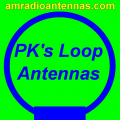G8JNJ
About
- Username
- G8JNJ
- Joined
- Visits
- 4,628
- Last Active
- Roles
- Member
- Points
- 127
Reactions
-
S-meter extension
Hi John,
This week I've been trying to use a number of KiWis to perform some antenna field strength measurements, but its been a somewhat frustrating process.
So I'd also like to echo Jim's request for an option to allow the the S-meter logging period to be even slower, perhaps up to 24hrs, so that I could also use it to monitor changes in my noise floor, signal levels from BC stations and other propagation related monitoring.
It's currently a real pain to have to derive this information from the graph image and the subsequent visual resolution is only about 3dB or so, it's also difficult to check for max values over a period of time or try to determine the signal average level. I know there is already a request to provide this functionality, but I also know that there are more pressing or higher priority fixes to be implemented first.
I wondered if it would be possible to add a function to store and be able to download the graphed dBm values as a CSV file. Each value to be timestamped and the header to the contain frequency and RX bandwidth.
This would permit much more detailed off-line analysis of max /min values, averages and other trends, which wouldn't need to be added to the existing graphing option. Maybe sampling intervals could be defined or automatically selected as a function of logging period so that huge files are not generated. Each time the S-meter restarts the file could be overwritten, perhaps a bit like the fax image files ?
Regards,
Martin - G8JNJ -
What is the status of the WSPR background and autostart features? [added in v1.181]
Hi John,
Also be aware that there is some controversy regarding the frequencies used for WSPR on 80m.
"with WSJT-X v1.8 we intend to correct an anomaly that has existed for a long time in that Japanese amateur radio operators have no privileges for the frequencies commonly used for WSPR, JT65 and JT9. The current frequencies (USB dial frequency) are:
WSPR 3.592600 MHz, JT65 3.576000 MHz, JT9 3.578000 MHz
because we strongly prefer that WSPR and JT mode frequencies are globally coordinated where possible, the proposed new frequencies are:
WSPR 3.568600 MHz, JT65 3.570000 MHz, JT9 3.572000 MHz, FT8 3.573000 MHz
This places the conventional 200 Hz wide WSPR sub-band (centred around +1500 Hz audio offset) into the lower 200 Hz the JT65 sub-band. The lower 200 Hz of the JT65 sub-band is not used due to SSB filter roll off."
Most folks are sticking with the original allocations, but you may wish to include the new(ish) proposed frequency in the KiWi WSPR decoder list of frequencies.
Regards,
Martin - G8JNJ -
LZ1AQ LNA and a 1.2 meter copper loop antenna.
Hi Ron,
Reducing the loop inductance (for a given size) is something worth trying if you want to improve the performance still further on the HF bands (>10MHz).
This is less critical when you are using a loop amplifier with a fairly high input impedance, but in the LZ1AQ design it is only in the region of a few ohms (which is great for the LF bands), so loop inductance becomes a critical factor as you go up in frequency.
You can either make the loop a lot 'fatter' to reduce the inductance, connect several same size loops in parallel (but spaced by a few inches), or cross-connect four or more independent loops together.
Chavdar has good notes on this subject on his website.
http://active-antenna.eu/tech-docs/3_ActiveAA_Antena_11.pdf
Regards,
Martin - G8JNJ -
Home Brew Broadband Magnetic Loop
Hi Ron,A couple of weeks ago I received a private email about this circuit, and decided to make a copy, as the person who wrote was having problems with it, and I couldn't figure out how the circuit could perform as described.I found that the IMD performance was poor and it had several other issues which couldn't be easily fixed.If you want to build or buy an amplifier of this type, my advice would be to take a look at the DXE RPA-1 circuit instead. Regards,Martin - G8JNJ
Regards,Martin - G8JNJ -
Wellgood balanced loop amplifier, (Wellbrook clone).
-
Wellgood balanced loop amplifier, (Wellbrook clone).
Hi Ron,It's basically two Norton lossless feedback amplifiers connected in a push pull arrangement.The winding in the emitter circuit provides negative feedback and the ratio of the windings sets the amount of feedback and therefore the overall gain of the amplifier stage.I'm not at home at the moment so I can't access my list of web links, but try a Google search for Chris Trask's papers on lossless feedback for more information.When you reduce the supply rail it may reduce the noise floor, and also possibly reduce the gain, which also may give the impression of reducing the noise floor. But below about 3v the bias point of the transistors is way off and the output power capability (and therefore IMD performance) is seriously reduced. What you are observing may actually be a secondary artifact resulting from something else changing which is in turn 'fixing' another problem such as FM BC interference, amplifier oscillation or some other out of band parameter which is impacting the overall performance.One final thing - it may be that George's 'reverse engineering' is not 100% accurate, especially regarding the construction and winding of the feedback transformer. I suspect that the two amplifiers maybe should be wound on two separate halves of the binocular core but that the input winding is common to both. This is how Trask has implemented some of his augmented push pull amplifiers, but I can't confirm this is how the Wellgood design works.If you have an opportunity I'd suggest that you also try the LZ1AQ amplifier design http://www.lz1aq.signacor.com/docs/wsml/wideband-active-sm-loop-antenna.htm as a comparison. It's actually easier to build if you leave out the regulator and just feed the output into coax rather than using CAT 5 / 6 cable.I found that the LZ1AQ performed at least as well, if not better, than the Wellgood clone. But as I stated earlier this may be actually be due to an error in the reverse engineered circuit.The Yahoo Groups Loops forum is other very useful source of information and is frequented by Trask and Wellbrook. There has been some discussion regarding the Wellgood copy and Wellbrook don't seem to be that bothered that the design is now out in the open. This could be because they have now moved to a new design, or it could be that George's Wellgood circuit isn't correct and they don't want this to be known.Regards,Martin - G8JNJ -
A Bias-T and active antenna performance
-
Home Brew Broadband Magnetic Loop
-
Wellgood balanced loop amplifier, (Wellbrook clone).
Hi Ron,My guess is that you have inadvertently scraped some of the enamel insulation off the transformer winding(s) at some point, as it's very easy to do this.I use Kynar insulated wire (the type sold for wire wrapping) wherever possible, as this is much more resilient. However this doesn't work with very small cores, as the wire is too thick, so in this case I just have to be extra careful when pulling the enamelled wire through the holes in the core.Regards,Martin - G8JNJ -
Use CAT6 shielded communications cable for antenna feedline, rotor control, and LNA power
Hi Ron,The LZ1AQ loop amplifier kit uses CAT6 for power, control and signal.CAT 5 & 6 has a characteristic impedance of 100 Ohms per twisted pair. You can build an impedance matching balun or use two pairs connected in parallel and a 1:1 balun. However if you use this method beware, as some CAT cables use different numbers of 'twists per inch' on the different cable pairs in order to reduce cross talk between pairs. This results in some pairs being electrically 'longer' than others., which may cause problems if you connect them in parallel to halve the impedance.Regards,Martin - G8JNJ




